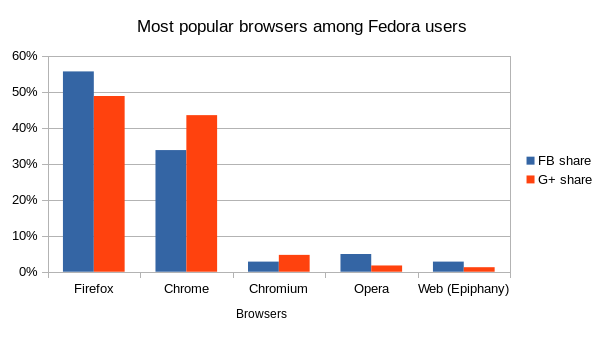Google Chrome is the most popular browser in the world. It is so popular that some call it a new Internet Explorer. But that’s based on global stats. In Red Hat, I’m responsible for web browsers, so I wondered what are the most popular web browsers among Fedora users. So I asked through Fedora accounts on Facebook and Google+: “Which browser do you use the most in Fedora?”
I didn’t look for exact numbers. It’s clear that such polls can’t be 100% representative and for instance Google+ users have inclination to use Google products which can be seen on the comparison of results from Facebook and Google+. However, I think the results give you a rough idea of what browsers are popular among Fedora users. And the results are:
 The surveys differed a bit. G+ supports polls, but only up to five options. So I pre-selected five browsers I expected would be most popular, and told the users to write a browser of their choice to comments if it’s not among pre-selected options. Facebook natively doesn’t support polls, so users wrote their preferences in comments. Even though other browsers were not discriminated by not being pre-selected the results were very similar. None of them got more votes than any of the pre-selected five. The total amount of votes on Facebook was considerable lower than on Google+ (1262). And the findings?
The surveys differed a bit. G+ supports polls, but only up to five options. So I pre-selected five browsers I expected would be most popular, and told the users to write a browser of their choice to comments if it’s not among pre-selected options. Facebook natively doesn’t support polls, so users wrote their preferences in comments. Even though other browsers were not discriminated by not being pre-selected the results were very similar. None of them got more votes than any of the pre-selected five. The total amount of votes on Facebook was considerable lower than on Google+ (1262). And the findings?
- Firefox and Chrome/Chromium are the only relevant browsers among Fedora users. They take up to 95% of the pie. Opera and Epiphany were a bit more popular among Fedora users on Facebook, but neither of them exceeded 5%. All other browsers got just a couple of votes: Midori, Konqueror, SeaMonkey, Pale Moon, Vivaldi, Lynx,…
- Firefox was the winner, a pretty clear one on Facebook and a close one on Google+ (49% vs 48%). Firefox is the default browser, so it’s not surprising.
- What really surprised me is the huge difference between Chrome and Chromium. I thought there would be more people who prefer open source solutions, but apparently a lot more people prefer convenience even among Fedora users. You can find Chromium in alternative repos and it’s easy to install, but it doesn’t include Flash player and other closed source goodies. With Chrome, you get it all with an installation of one package. In terms of numbers of users, Chromium is pretty much irrelevant if you compare it to Chrome.
- Quite a few people said that they were primarily using Firefox, but they had Chrome for Flash. When Flash goes finally away, Chrome will lose one of its significant advantages.
- Opera used to have a market share of ~10% among Linux users. In this survey, it got 4.9% (FB) and 1.7% (G+). It took them more one year to release the new generation of Opera (based on Chromium) for Linux after they discontinued the original Opera (12.16). Apparently most users left and never came back (I’m one of them).
Leave a Reply